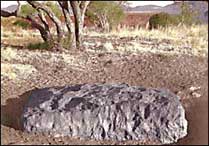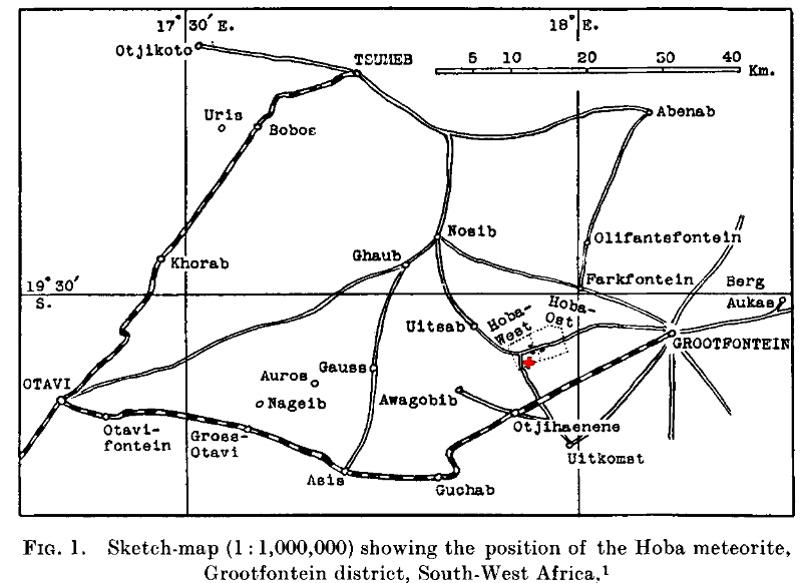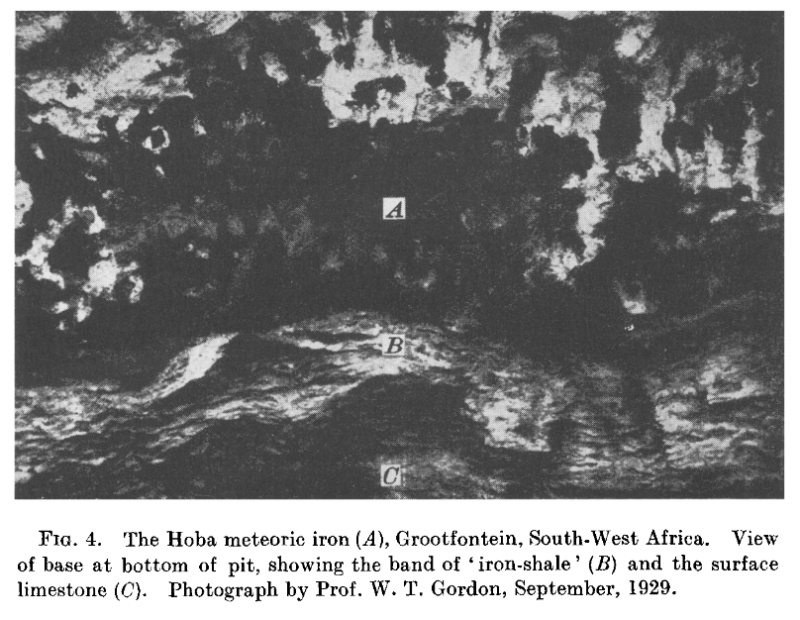Hoba - The Largest Known Meteorite on Earth
Jan 14, 2022 11:52:54 GMT -5
catskillrocks, RWA3006, and 6 more like this
Post by 1dave on Jan 14, 2022 11:52:54 GMT -5
en.wikipedia.org/wiki/Hoba_meteorite

The Hoba[1] (/ˈhoʊbə/ HOH-bə) meteorite, short for Hoba West, is a meteorite that lies on the farm of the same name, not far from Grootfontein, in the Otjozondjupa Region of Namibia. It has been uncovered but, because of its large mass, has never been moved from where it fell. The main mass is estimated at more than 60 tonnes.[1] It is the largest known intact meteorite (as a single piece)[2] and about twice as massive as the largest fragment of either the Cape York meteorite's 31-tonne Ahnighito kept in Manhattan or the Campo del Cielo's 31-tonne Gancedo in Argentina. It is also the most massive naturally occurring piece of iron (actually ferronickel) known on Earth's surface. The name "Hoba" comes from Khoekhoegowab word meaning "gift".[3] Following donation to the government in 1987 a visitor centre was constructed with a circular stone access and seating area.
Contents
1 Impact
2 Discovery
3 Description and composition
4 Modern history
5 See also
6 Notes and references
7 Further reading
Impact
The Hoba meteorite impact is thought to have occurred more recently than 80,000 years ago. It is inferred[4] that the Earth's atmosphere slowed the object in such a way that it impacted the surface at terminal velocity, thereby remaining intact and causing little excavation (expulsion of earth). Assuming a drag coefficient of about 1.3, the meteor appears to have slowed to about 320 m/s (720 mph) from an entry speed to the atmosphere typically in excess of 10 km/s (22,370 mph). The meteorite is unusual in that it is flat on both major surfaces.
Discovery
The Hoba meteorite left no preserved crater and its discovery was a chance event. In 1920,[1] the owner of the land, Jacobus Hermanus Brits, encountered the object while ploughing one of his fields with an ox. During this task, he heard a loud metallic scratching sound and the plough came to an abrupt halt. The obstruction was excavated, identified as a meteorite and described by Mr. Brits, whose report was published in 1920 and can be viewed at the Grootfontein Museum in Namibia.
Friedrich Wilhelm Kegel took the first published photograph of the Hoba meteorite.[5]
Description and composition
Comparison of approximate sizes of notable impactors with the Hoba meteorite, a Boeing 747 and a New Routemaster bus
Hoba is a tabloid body of metal, measuring 2.7×2.7×0.9 m (8 ft 10 in×8 ft 10 in×2 ft 11 in). In 1920 its mass was estimated at 66 tonnes. Erosion, scientific sampling and vandalism reduced its bulk over the years. The remaining mass is estimated at just over 60 tonnes. The meteorite is composed of about 84% iron and 16% nickel, with traces of cobalt. It is classified as an ataxite iron meteorite belonging to the nickel-rich chemical class IVB. A crust of iron hydroxides is locally present on the surface due to weathering oxidation.
Modern history
In an attempt to control vandalism, with permission from the farm-owner, the government of South West Africa (now Namibia) on March 15, 1955, declared the Hoba meteorite to be a national monument.[6] Since 1979 the proclamation has been extended to land of 425 m².[7]
In 1987 the farm owner donated the meteorite and the site where it lies to the state for educational purposes. Later that year, the government opened a tourist centre at the site.[7] As a result of these developments, vandalism of the Hoba meteorite has ceased and it is now visited by thousands of tourists every year.

The Hoba meteorite before the construction of the circular steps.

The Hoba[1] (/ˈhoʊbə/ HOH-bə) meteorite, short for Hoba West, is a meteorite that lies on the farm of the same name, not far from Grootfontein, in the Otjozondjupa Region of Namibia. It has been uncovered but, because of its large mass, has never been moved from where it fell. The main mass is estimated at more than 60 tonnes.[1] It is the largest known intact meteorite (as a single piece)[2] and about twice as massive as the largest fragment of either the Cape York meteorite's 31-tonne Ahnighito kept in Manhattan or the Campo del Cielo's 31-tonne Gancedo in Argentina. It is also the most massive naturally occurring piece of iron (actually ferronickel) known on Earth's surface. The name "Hoba" comes from Khoekhoegowab word meaning "gift".[3] Following donation to the government in 1987 a visitor centre was constructed with a circular stone access and seating area.
Contents
1 Impact
2 Discovery
3 Description and composition
4 Modern history
5 See also
6 Notes and references
7 Further reading
Impact
The Hoba meteorite impact is thought to have occurred more recently than 80,000 years ago. It is inferred[4] that the Earth's atmosphere slowed the object in such a way that it impacted the surface at terminal velocity, thereby remaining intact and causing little excavation (expulsion of earth). Assuming a drag coefficient of about 1.3, the meteor appears to have slowed to about 320 m/s (720 mph) from an entry speed to the atmosphere typically in excess of 10 km/s (22,370 mph). The meteorite is unusual in that it is flat on both major surfaces.
Discovery
The Hoba meteorite left no preserved crater and its discovery was a chance event. In 1920,[1] the owner of the land, Jacobus Hermanus Brits, encountered the object while ploughing one of his fields with an ox. During this task, he heard a loud metallic scratching sound and the plough came to an abrupt halt. The obstruction was excavated, identified as a meteorite and described by Mr. Brits, whose report was published in 1920 and can be viewed at the Grootfontein Museum in Namibia.
Friedrich Wilhelm Kegel took the first published photograph of the Hoba meteorite.[5]
Description and composition
Comparison of approximate sizes of notable impactors with the Hoba meteorite, a Boeing 747 and a New Routemaster bus
Hoba is a tabloid body of metal, measuring 2.7×2.7×0.9 m (8 ft 10 in×8 ft 10 in×2 ft 11 in). In 1920 its mass was estimated at 66 tonnes. Erosion, scientific sampling and vandalism reduced its bulk over the years. The remaining mass is estimated at just over 60 tonnes. The meteorite is composed of about 84% iron and 16% nickel, with traces of cobalt. It is classified as an ataxite iron meteorite belonging to the nickel-rich chemical class IVB. A crust of iron hydroxides is locally present on the surface due to weathering oxidation.
Modern history
In an attempt to control vandalism, with permission from the farm-owner, the government of South West Africa (now Namibia) on March 15, 1955, declared the Hoba meteorite to be a national monument.[6] Since 1979 the proclamation has been extended to land of 425 m².[7]
In 1987 the farm owner donated the meteorite and the site where it lies to the state for educational purposes. Later that year, the government opened a tourist centre at the site.[7] As a result of these developments, vandalism of the Hoba meteorite has ceased and it is now visited by thousands of tourists every year.

The Hoba meteorite before the construction of the circular steps.

















